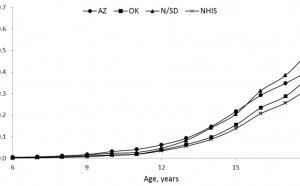
Tobacco Use in America
Smoking and tobacco use pose a serious risk of death and disease for women. Annually, cigarette smoking kills an estimated 201, 770 women in the U.S.1
In 2013, 15.3 percent of women in the U.S. smoked, compared to 20.5 percent of men.2 Today, with a much smaller gap between men's and women's smoking rates, women share a much larger burden of smoking-related diseases.
- The smoking rate for women in some racial/ethnic groups is higher than in others. For example, the 2013 smoking rate for American Indian/Alaska Native women was 22.0 percent while the rate for white women was 17.8 percent and for Hispanic women just 7.0 percent.2
- The smoking rate is also much higher for lesbian and bisexual women than for heterosexual women. In 2013, the smoking rate for women who identify as bisexual or lesbian was 26.7 percent compared to just 15.0 percent for women who identify as straight.2 This is likely the result of multiple factors including social stigma, discrimination and targeted marketing by the tobacco industry.
- Smoking is directly responsible for 80 percent of lung cancer deaths in women in the U.S. each year.3 In 2013, an estimated 70, 542 women died of lung and bronchus cancer.4
- In 1987, lung cancer surpassed breast cancer as the leading cause of cancer deaths among women in the U.S.4
- From 1959 to 2010, the risk of developing lung cancer increased tenfold for women. This is thought to be at least partially due to the manipulation of cigarettes by tobacco companies.1
- Female smokers are nearly 22 times more likely to die from chronic obstructive pulmonary disease (COPD), which includes emphysema and chronic bronchitis, compared to women who never have smoked.1
- Women who smoke may develop more severe COPD earlier in life.1
- Women who smoke also have an increased risk for developing cancers of the oral cavity, pharynx, larynx (voice box), esophagus, pancreas, kidney, bladder and uterine cervix. They also double their risk for developing coronary heart disease.5
- Postmenopausal women who smoke have lower bone density than women who never smoked. Women who smoke have an increased risk for hip fracture compared to never smokers. Cigarette smoking also causes skin wrinkling that could make smokers appear less attractive and prematurely old.5
- Women have been extensively targeted in tobacco marketing dominated by themes of an association between social desirability, independence, weight control and smoking messages conveyed through advertisements featuring slim, attractive, and athletic models.
- Teenage girls often start to smoke to avoid weight gain and to identify themselves as independent and glamorous, which reflect images projected by tobacco advertising. Cigarette advertising portrays cigarettes as causing slimness and implies that cigarette smoking suppresses appetite.
VIDEO REVIEWS

Teens Against Tobacco Use

Destiny

American Indians Talk about Tobacco Abuse
Share this Post
Related posts
History of tobacco use in American
JULY 27, 2024
(Adapted from Tobacco Timeline by Gene Borrio.) The native people of the Americas considered tobacco a gift from the Great…
Read MoreTobacco history in American
JULY 27, 2024
Washington Duke In 1865, Washington Duke of North Carolina was released from Libby Prison, having been captured during the…
Read More










